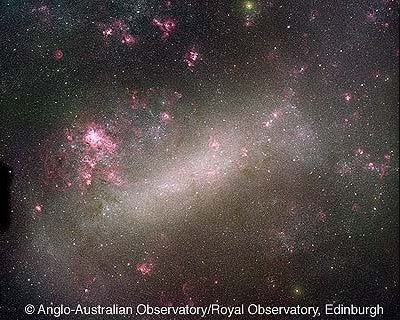Big or small, we all come into this world the same way. This now also appears to apply to the birth of galaxies. Peering out at one of our neighboring galactic satellites, astronomers have discovered fresh evidence that it may share a similar evolutionary past with the Milky Way.
Using the European Southern Observatory’s (ESO) Very Large Telescope (VLT) in northern Chile in January 2003, an international group of scientists has found signs of an ancient stellar halo enveloping the Large Magellanic Cloud (LMC), similar to that observed around our own galaxy.
Forming a spherical halo of giant elderly stars around the Milky Way, RR Lyrae stars can be used as a marker to find a similar population of these stellar seniors in the LMC. RR Lyrae stars are classified as old, giant, pulsating variables residing mostly in globular clusters and in galactic halos. They are used as a reliable measuring stick for up to 650,000 light-years distance.
By combing through the data of over 8,000 RR Lyrae collected for the MACHO (Massive Compact Halo Objects) microlensing project in only a 10-square-degree region, the study team was able to harvest 43 individual RR Lyrae stars located in the LMC. Kem Cook, team member from Lawrence Livermore National Laboratory in California and original discoverer of these LMC stars says that RR Lyrae are an easily identifiable tracer of old, metal-poor stellar populations.
By studying the rapid, random movements of these sample stars, the researchers were able to determine the existence of an ancient stellar halo in the LMC. This new discovery shows that the LMC and other smaller galaxies like it may contain halos similar to our own galaxy, suggesting a comparable formation history.
Clues to the formation theories for our Milky Way and other large spiral galaxies have been derived from studying these same types of stars (population II) on the outskirts of the galaxy. Amounting only to 2 percent of the entire mass of the LMC, the RR Lyrae count in the LMC matches that surveyed in our galaxy.
Astronomers suggest that these findings will narrow the possible methods by which galaxies similar to our own are formed to two scenarios. Either satellite galaxies with existing old stars are gobbled up by larger galaxies creating a stellar halo (hierarchical accretion), or before the nascent disk of a spiral galaxy collapses there is a gigantic expulsion of its elderly stellar residents into a spherical halo (rapid collapse).
“The bottom line is that the Large Magellanic Cloud seems to have had a similar early formation history as the Milky Way,” says Cook.
The team reported its results in the September 12 issue of Science.










